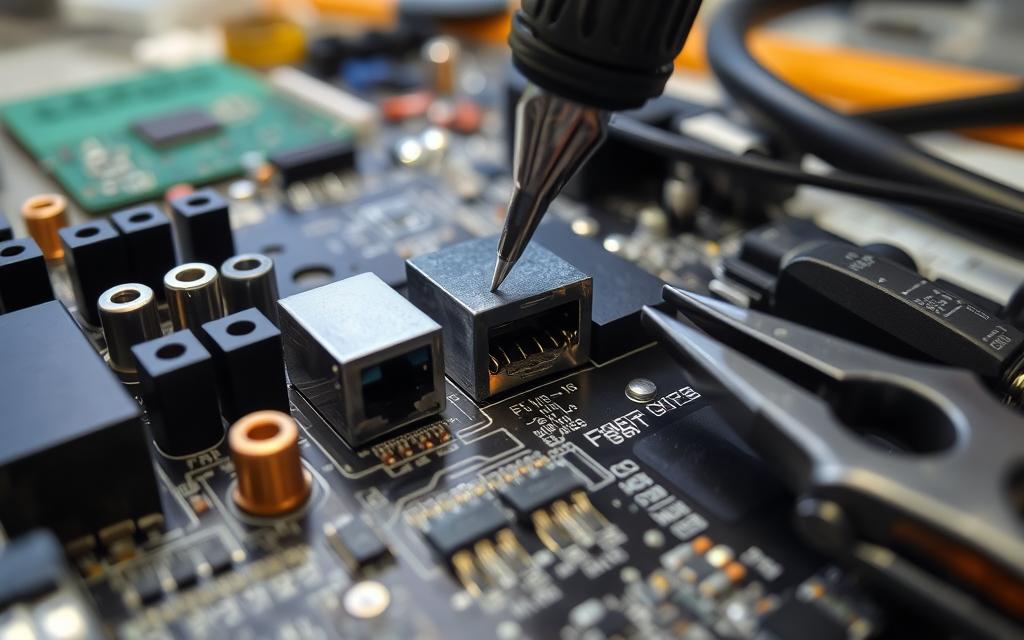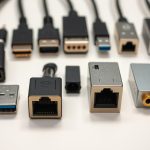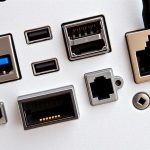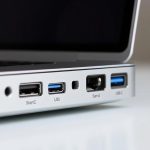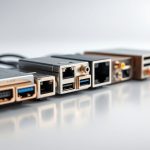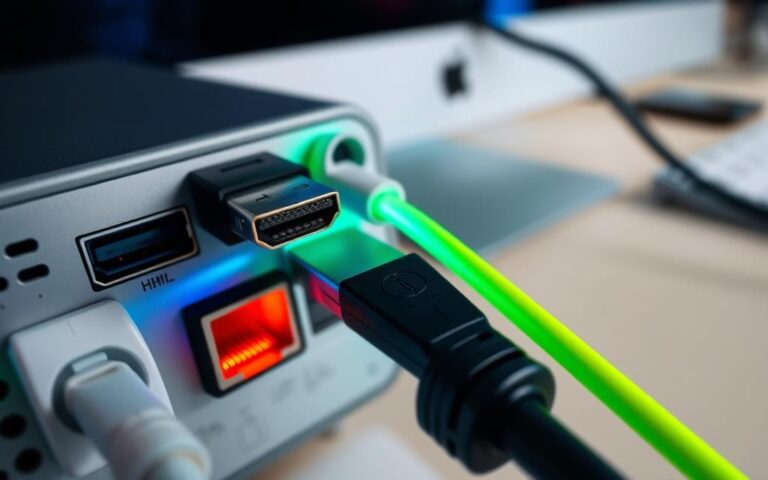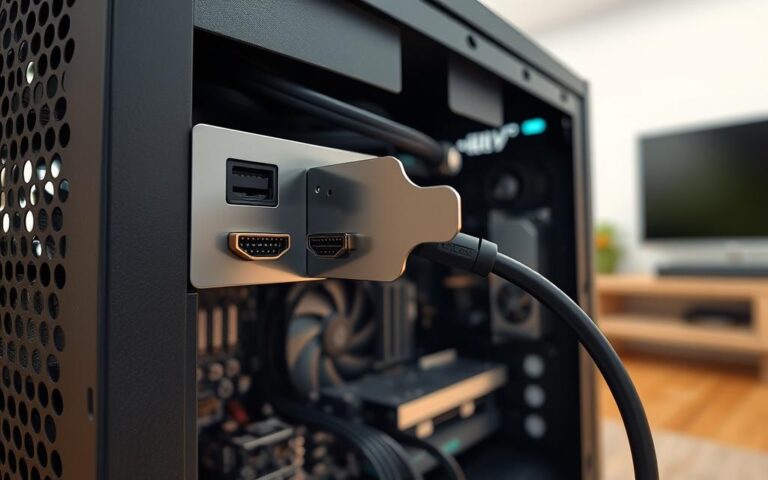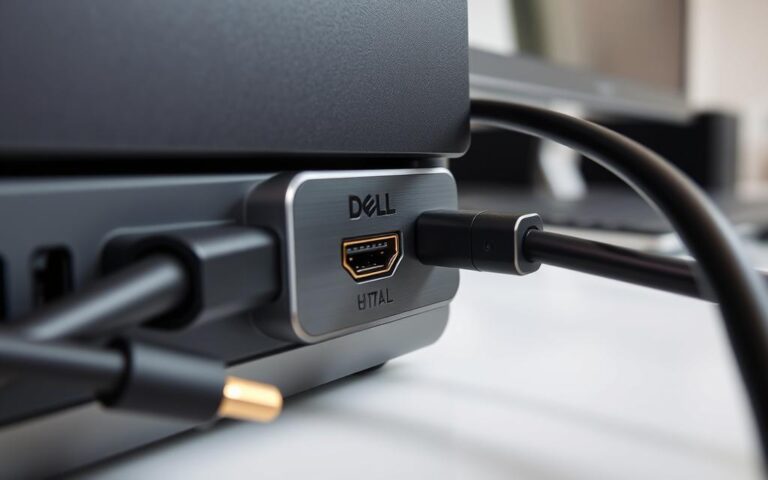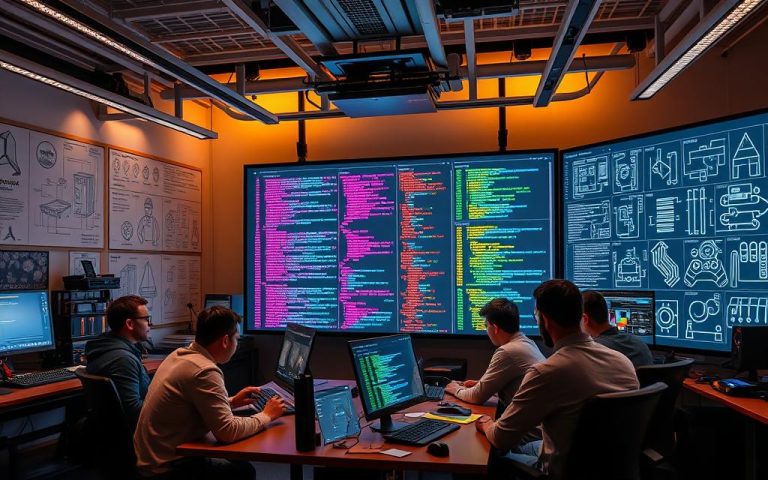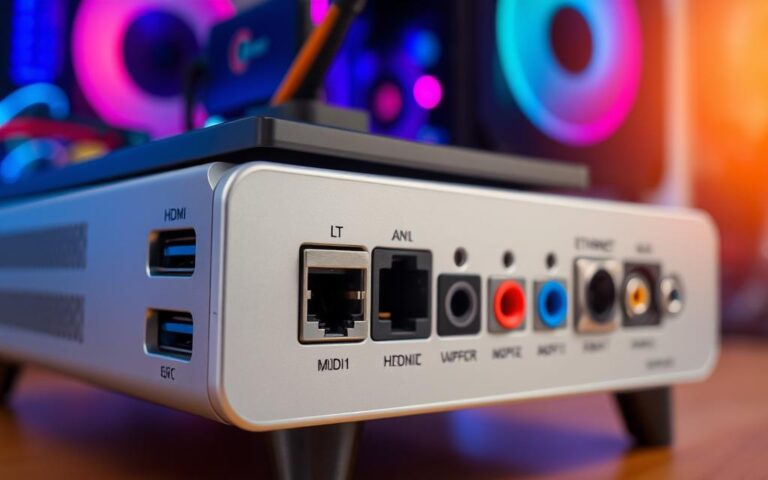Steps to Add an HDMI Port to a Computer
Today, connecting your computer to high-definition displays is crucial. Many need to add an HDMI port to their systems. This could be for gaming, streaming, or boosting their workstation setup. This guide will explain how to add HDMI connections to your computer for both desktop and laptop users.
Interestingly, many desktop computers don’t have HDMI ports. This often means having to upgrade the computer to get this feature. For laptops, using an HDMI adapter might be a better choice because upgrading can be hard. There are affordable graphics cards and adapters that can improve your computer’s video output easily.
Whether you’re upgrading, using an HDMI adapter, or just need tips on connecting your new setup, this article has you covered. It will guide you through each step to achieve high-definition connectivity with ease.
Understanding HDMI and Its Importance
HDMI stands for High-Definition Multimedia Interface. It’s key for sending both video and audio in high-definition through one cable. This makes connecting devices like computers, TVs, and consoles easier. It’s a vital part of today’s tech setups.
What is HDMI?
HDMI is more than just a cable connection. It allows the smooth transmission of high-quality content. With lots of high bandwidth content around, HDMI’s ability to handle it efficiently is crucial. It works with many devices, making it easy to enjoy high-def content without juggling numerous cables.
Benefits of HDMI Connections
HDMI offers clear advantages. It means less cable clutter because you need fewer cables, making setups tidier. It supports 4K and higher resolutions, letting users enjoy crisp visuals. Combining audio and video in one cable adds convenience, making HDMI a top choice for streaming and gaming fans.
Assessing Your Computer’s Current Setup
A closer look at your computer setup is vital for improving your multimedia enjoyment. This means checking which ports you have and if you need an HDMI port. It’s all about seeing what ports you have and if they work with new displays.
Identifying Existing Ports on Your Computer
Start by examining the back and front of your computer for connection points. You might find ports such as:
- VGA
- DVI
- HDMI
- DisplayPort
Many people have these ports already, especially HDMI. It’s found in lots of new graphic cards. Knowing what ports you have helps figure out how to connect to external displays.
Recognising the Need for HDMI
Old tech like VGA and DVI has its limits, particularly for high-definition content. Anyone seeking the best quality will see why HDMI is needed. HDMI carries better resolutions and sound, making your multimedia experience richer.
To grasp HDMI’s value, consider these aspects:
| Port Type | Maximum Resolution | Audio Support |
|---|---|---|
| VGA | 1920 x 1080 | No |
| DVI | 1920 x 1200 | Limited |
| HDMI | 4K and beyond | Yes |
How to Add HDMI Port to Computer
Deciding how to add HDMI ports to your computer involves two main choices. You can upgrade your hardware or use HDMI adapters. It depends on your computer type. Desktop users might prefer upgrading. For laptops, HDMI adapters are often the best bet.
Determining the Best Method: Upgrade vs. Adapter
For desktops, adding a new graphics card with an HDMI port is a good move. You can find such graphics cards for under £50. They offer better performance than built-in options. To install, you remove the computer case, slot in the new card, and set up the software.
Laptops might not be as easy to upgrade internally. This is where HDMI adapters come in. They include VGA to HDMI converters. These converters change analog signals to digital. This lets you link older laptops to new screens.
Available Options for Adding HDMI
There are many ways to add HDMI ports, depending on what you need and your budget:
- Budget Graphics Cards: These are affordable and come with HDMI output.
- External HDMI Adapters: Great for laptops and desktops without room for upgrades.
- DVI to HDMI Cables: Perfect for connecting DVI outputs to HDMI inputs without hassle.
- Multi-Input HDMI Cards: They allow video capture from multiple sources at once, for those who need it.
- 4K HDMI Cards: Best for capturing high-definition content in 4K.
Upgrading with a Graphics Card
Adding a graphics card with an HDMI port can make a big difference. It’s both affordable and useful. With it, you’ll get better sound and picture when using your computer. Knowing which graphics card to pick can improve your computer’s performance and connect easily with new screens.
Choosing the Right Graphics Card
Think about your budget and what you need before choosing a graphics card. You can find a good one for less than $50. It’ll be better than the basic graphics already in your computer. Make sure it has an HDMI output to work with your screen or TV. Brands like NVIDIA and AMD have many options for different needs.
Installation Steps for a Graphics Card
Putting in a new graphics card is pretty simple. First, turn off and unplug your computer. Then, open the case and find the PCI slot on the motherboard. Place the new graphics card into the slot carefully and make sure it’s secure. Keep the card steady in the case to avoid any damage.
Software and Driver Installation
After the graphics card is in, you need to install HDMI drivers. These drivers let your computer use the new card. You can get them from the card maker’s website or they might install by themselves. Keep the drivers updated for the best performance. You might need to change some settings to get the HDMI to work right.
Using an HDMI Adapter
Today, connecting older computers without HDMI ports to modern screens is common. HDMI adapters help solve this problem, making connections easy. We’ll look at VGA to HDMI and DVI to HDMI adapters and their benefits.
Understanding Different Types of Adapters
HDMI adapters are key for linking old and new tech. There are various types, such as:
- VGA to HDMI: Turns analogue VGA signals into digital HDMI, great for old PCs.
- DVI to HDMI: Good for video connections, it sends high-quality video signals.
- USB to HDMI: Ideal when you don’t have an HDMI port, connects through USB.
Setting Up a VGA to HDMI Adapter
Setting up a VGA to HDMI adapter is simple. First, connect your computer’s VGA to the adapter’s input. Don’t forget the audio cables, as many adapters also send sound. Then, plug the HDMI end into your screen. This changes the VGA signal to HDMI, making your content look better.
Utilising DVI to HDMI Connections
Using a DVI to HDMI adapter is also a smart option. You can find DVI to HDMI adapter cables in stores. Just connect the DVI from your computer to the adapter. Then, link the HDMI end to your display. This keeps your video quality high. It’s a solid choice for those wanting easy, high-quality connections.
| Adapter Type | Connection Type | Audio Support | Typical Use Case |
|---|---|---|---|
| VGA to HDMI | VGA (analogue) to HDMI (digital) | Yes, via additional connections | Old computers to modern displays |
| DVI to HDMI | DVI (digital) to HDMI (digital) | No | Video connection for monitors |
| USB to HDMI | USB to HDMI | Varies by adapter | Convenient for laptops without HDMI ports |
Testing Your New HDMI Connection
Once you’ve added the HDMI port, it’s time to connect your monitor or TV. This step is key to check the HDMI setup works well with your system. Use a good HDMI cable to link your display to your computer’s HDMI port. Make sure you’ve chosen the correct input source on your screen. This ensures the best display while you adjust settings.
Connecting Your Monitor or TV
Start by securely plugging the HDMI cable into both your computer and your display. Then, turn on both devices to see if the display recognises the connection. If nothing shows up, you might need to change the input settings on your screen. Just go through the input/source options to fix it. This is crucial for getting your display into the right mode.
Troubleshooting Connection Issues
If you run into problems, there are steps you can take. First, check that the HDMI cable is connected properly. Try using different HDMI cables to find the issue. If you still have problems, look at your computer’s display settings or restart both your devices. For harder issues, looking into software settings is key. Updating your Windows and graphics drivers can fix many problems. Rebooting in Safe Mode helps find software clashes. If you see a black or messed up screen, check the HDMI port for any damage like broken pins.
Following these tips should help solve most HDMI connection problems. Getting perfect HD quality is usually just a few tweaks away. This makes enjoying your HDMI setup easier. For those thinking about more HDMI upgrades, check out this detailed guide.
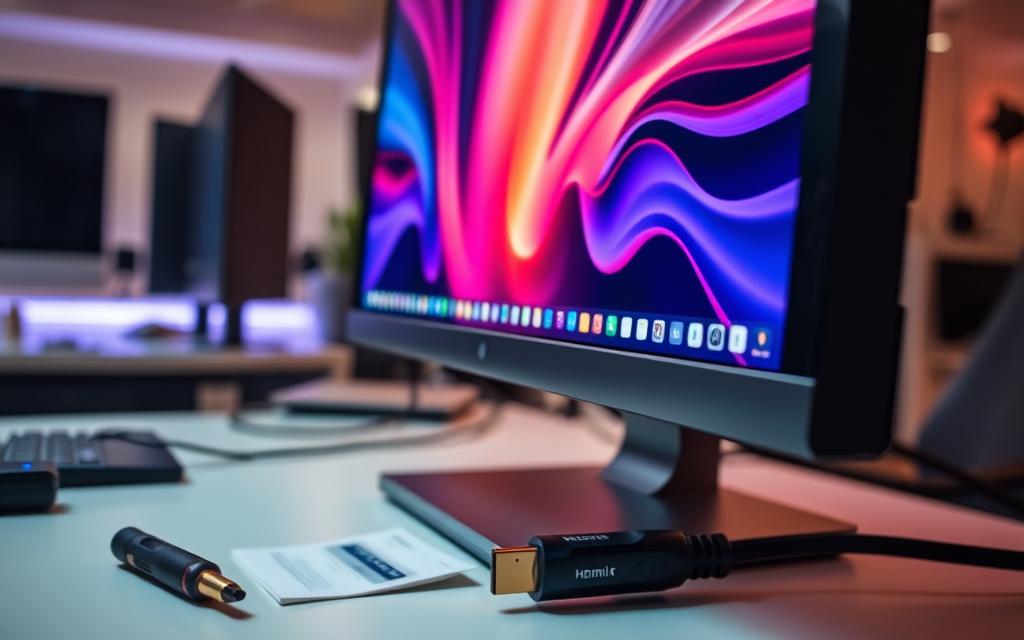
Alternative Solutions for HDMI Connectivity
In today’s world, people often look for other ways to connect their devices without wires. They want flexibility and convenience. If you’re searching for a wireless HDMI choice or something more adaptable, you’ll find many options available.
Wireless HDMI Transmitters
Wireless HDMI transmitters are a top pick for sending content from a PC to a HDMI screen cable-free. They work up to about 150 feet away. This lets you place your devices wherever you like best. Due to their ease of use and neatness, about 65% of shoppers choose wireless over wires. People love the simplicity and the ease they bring, perfect for watching movies at home or giving a presentation at work.
Docking Stations with HDMI Outputs
Docking station HDMI setups are a smart pick for adding connections. They let you link several devices and HDMI screens. These stations have many ports, ideal for those who use lots of multimedia tools. They range from affordable choices that support 1080p to ones that offer 4K resolution. They handle all your connection needs very well. For tips on adding more HDMI ports, check out this helpful article.
So, HDMI alternatives like wireless HDMI tech and handy docking stations make improving your setup a breeze. Nowadays, anyone can find the right fit to enhance their tech experience.
Conclusion
Adding an HDMI port to your computer is easy and opens up new multimedia possibilities. You can choose between upgrading your graphics card or using HDMI adapters. Each method meets different needs and setups, making your computer a hub for multimedia.
Different HDMI cables and adapters offer unique connections. Knowing about Standard and Mini HDMI helps you understand your options. Adapters also make it easy to connect devices without HDMI outputs. This knowledge helps smoothly move to modern display technologies.
If you have questions or need more help, this information is here for you. HDMI technology greatly boosts productivity and entertainment on computers. It brings a lot of opportunities for better display and experience.
FAQ
What does HDMI stand for?
HDMI means High-Definition Multimedia Interface. It’s a way to send high-quality video and audio from one device to another.
Why is HDMI important for computers?
HDMI connects computers to HD displays like monitors and TVs. It gives better picture and sound, reducing the need for many cables.
Can I add an HDMI port to my old computer?
Yes, you can add HDMI to an old computer. Upgrade the graphic card or use an adapter from VGA or DVI to HDMI.
What factors should I consider when choosing a graphics card?
Look at compatibility with your computer and what you need it for, like gaming. Make sure it has an HDMI port.
How do I know if my computer has available ports for an HDMI upgrade?
Check your computer’s specs for ports like VGA, DVI, and HDMI. This will show if you can upgrade.
What types of HDMI adapters are available?
There are VGA to HDMI and DVI to HDMI adapters. They change analogue signals to digital for devices without HDMI.
How do I troubleshoot an issue with my new HDMI connection?
For HDMI issues, make sure the cable is plugged in tight. Check your display settings and update your hardware or software if needed.
Are there wireless options for HDMI connectivity?
Yes, wireless HDMI transmitters and docking stations with HDMI outputs let you stream without physical cables. Great for tidy workspaces.

